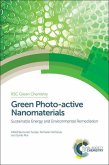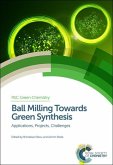Developments and Applications in Solubility
Herausgeber: Letcher, Trevor
Developments and Applications in Solubility
Herausgeber: Letcher, Trevor
- Gebundenes Buch
- Merkliste
- Auf die Merkliste
- Bewerten Bewerten
- Teilen
- Produkt teilen
- Produkterinnerung
- Produkterinnerung
This new book discusses important topics on one of the most basic of thermodynamic properties, namely SOLUBILITY - a property which underlies most industrial processes. The objective of the book is to bring together new, exciting and disparate topics, all related to Solubility, in a single volume, so that readers can extend their horizons and relate hitherto unrelated topics, leading to innovative and creative ideas. The book is a definitive and comprehensive reference to what is new in solubility and is ideal for research scientists, industrialists and academics
Andere Kunden interessierten sich auch für
![Electroanalytical Chemistry Electroanalytical Chemistry]() Electroanalytical Chemistry219,99 €
Electroanalytical Chemistry219,99 €![Green Photo-Active Nanomaterials Green Photo-Active Nanomaterials]() Green Photo-Active Nanomaterials262,99 €
Green Photo-Active Nanomaterials262,99 €![The Chemistry of Membranes Used in Fuel Cells The Chemistry of Membranes Used in Fuel Cells]() The Chemistry of Membranes Used in Fuel Cells175,99 €
The Chemistry of Membranes Used in Fuel Cells175,99 €![Introduction to Electrochemical Science and Engineering Introduction to Electrochemical Science and Engineering]() Serguei N LvovIntroduction to Electrochemical Science and Engineering154,99 €
Serguei N LvovIntroduction to Electrochemical Science and Engineering154,99 €![Ball Milling Towards Green Synthesis Ball Milling Towards Green Synthesis]() Ball Milling Towards Green Synthesis226,99 €
Ball Milling Towards Green Synthesis226,99 €![Blue Bioeconomy Blue Bioeconomy]() Blue Bioeconomy146,99 €
Blue Bioeconomy146,99 €![Sustainable Catalysis for Biorefineries Sustainable Catalysis for Biorefineries]() Sustainable Catalysis for Biorefineries214,99 €
Sustainable Catalysis for Biorefineries214,99 €-
-
-
This new book discusses important topics on one of the most basic of thermodynamic properties, namely SOLUBILITY - a property which underlies most industrial processes. The objective of the book is to bring together new, exciting and disparate topics, all related to Solubility, in a single volume, so that readers can extend their horizons and relate hitherto unrelated topics, leading to innovative and creative ideas. The book is a definitive and comprehensive reference to what is new in solubility and is ideal for research scientists, industrialists and academics
Hinweis: Dieser Artikel kann nur an eine deutsche Lieferadresse ausgeliefert werden.
Hinweis: Dieser Artikel kann nur an eine deutsche Lieferadresse ausgeliefert werden.
Produktdetails
- Produktdetails
- Verlag: RSC Publishing
- Seitenzahl: 414
- Erscheinungstermin: 12. Februar 2007
- Englisch
- Abmessung: 236mm x 157mm x 28mm
- Gewicht: 794g
- ISBN-13: 9780854043729
- ISBN-10: 0854043721
- Artikelnr.: 25541687
- Herstellerkennzeichnung
- Libri GmbH
- Europaallee 1
- 36244 Bad Hersfeld
- gpsr@libri.de
- Verlag: RSC Publishing
- Seitenzahl: 414
- Erscheinungstermin: 12. Februar 2007
- Englisch
- Abmessung: 236mm x 157mm x 28mm
- Gewicht: 794g
- ISBN-13: 9780854043729
- ISBN-10: 0854043721
- Artikelnr.: 25541687
- Herstellerkennzeichnung
- Libri GmbH
- Europaallee 1
- 36244 Bad Hersfeld
- gpsr@libri.de
Part One: THEORY, TECHNIQUES AND RESULTS
Chapter 1: Thermodynamics of Nonelectrolyte Solubility
1: Introduction
2: Thermodynamics
3: Subtleties of Approximation
4: Concluding Remarks
Chapter 2: Thermodynamics of Electrolyte Solubility
1: Introduction
2: The Solubility Product
3: Ion Pairing
4: Complexation
5: Electrolye Activities
6: Pitzer Theory
7: Treatment of Non-Aqueous or Mixed Aqueous Solvents
Chapter 3: Experimental, Calculated and Predicted Solubilities - Basis for the Synthesis and Design of Thermal Separation Processes
1: Introduction
2: Thermodynamic Fundamentals
3: Available Solubility Data
Software Package (DDBSP)
4: Conclusion
Chapter 4: Solubility of Gases in Ionic Liquids, Aqueous Solutions and Mixed Solvents
1: Introduction
2: Fundamentals
3: Experimental Arrangements
Apparatus for measuring the solubility of a single gas in a solvent at elevated pressures
Apparatus for measuring the simultaneous solubility of ammonia and a sour gas in a solvent at elevated pressures
Apparatus for measuring the solubility of a sour gas in aqueous solutions of amines at low pressures
4: Experimental Results and Comparison with Predictions/Correlations
Gas solubility in ionic liquids
Gas solubility in aqueous solutions of strong electrolytes
Solubility of ammonia and sour gases in water and aqueous solutions of strong electrolytes
Solubility of sour gases in aqueous solutions of amines
Gas solubility in mixed solvents (water + organic compounds)
Gas solubility in mixed solvents (water + organic compound + strong electrolyte)
Chapter 5: SOLUBILITY PHENOMENA IN "GREEN" QUATERNARY MIXTURES (Ionic Liquid + Water + Alcohol + CO2)
1: Introduction
2: Liquid-Liquid Equilibria: Co-solvent effects in Ternary Mixtures
3: Liquid-Liquid-Vapour Equilibria: The CO2 anti-solvent effect.
4: Quaternary systems IL + water + alcohol + CO2
Cascade of phase changes as switching devices for integrated reaction + separation
Chapter 6: The Solubility of Gases in Water and Seawater
1: Introduction
2: Quantities Used as a Measure of Gas Solubility
3: Oxygen Solubility in Water
4: Two Related Experiments that Complement Gas Solubility Data
5: Treatment of Data
6: The Solubility of Gases in Water
7: Annotated Bibliography of the Solubility of Gases in Water
8: Annotated Bibliography of the Solubility of Gases in Seawater
9: Summary
Chapter 7: Isotope Effects on Solubility
1: Introduction
2: Theoretical Background
3: Liquid-Liquid Equilibria
3.1: Small Molecule Solutions Including Aqueous Systems
3.2: Polymer Systems and Polymer Solutions
4: Solubility of Gases in Liquids
5: Solubility of Ionic Solids in H2O/D2O
Chapter 8: Solubility of Organic Solids for Industry
1: Introduction
2: Solubility in Binary Systems
1.1: Solid-Liquid Equilibria in Binary Systems
1.2: Liquid-Liquid Equilibria in Binary Systems
3: Solubility in Ternary Systems
3.1: Solubility of Solids in Binary Solvent Mixtures
3.2: Solubility of Mixtures of Two Solids in a Solvent
3.3: Liquid-Liquid Equilibria in Ternary Systems
4: Correlation Methods
5: Prediction Methods
6: High Pressure Solid-Liquid Equilibria
7: Polymers Solubility
8: Ionic Liquids Solubility
Chapter 9: CO2 Solubility in Alkylimidazolium-Based Ionic Liquids
1: Introduction
Symbolism
2: Phase Behaviour
3: Molecular Interactions
4: Effect of Anion
5: Effect of Cation Alkyl Chain Length
6: Substitution in C2 Position
7: Effects of Impurities
8: Conclusions and Summary
Part Two: MODELLING AND SIMULATION
Chapter 10: Solubility and Molecular Modelling
1: Introduction
2: Thermodynamics of Solution
3: Modelling Solubility
Molecular Force Fields
Free Energy Routes
4: Solute-Solvent Interactions in Ionic Liquids
5: Conclusion
Chapter 11: Molecular Simulation Approaches to Solubility
1: Introduction
2: Solubility
3: Computing Solubility for the Infinite Dilution Limit
Thermodynamic Integration
Free Energy Perturbation
Expanded Ensembles
Transition Matrix Monte Carlo
Gibbs Ensemble
Continuum Solvation Models
4: Computing the Solubility Limit
5: Finite Size Effects
Chapter 12: Prediction of Solubility with COSMO-RS
1: Introduction
2: COSMO-RS
3: Computational Details
4: Solubility
5: Salt Solubility
6: Summary and Conclusions
Part Three: INDUSTRIAL APPLICATIONS
Chapter 13: Solubility of impurities in cryogenic liquids
1: Introduction
2: Loss of Prevention in Cryogenic Plants
3: Experimental Methods
Synthetic-Optical Method
Evaporation Method
The static-analytical methods: spectroscopic analysis
The static-analytical methods: Chromatographic analysis
4: Review of Literature data
5: Conclusions
Chapter 14: Solubility of BTEX and Acid Gases in Alkanolamine Solutions in relation to the Environment
1: Introduction
2: Choice of Amine
3: Experimental Techniques
4: Experimental Results
5: Thermodynamics Frameworks
6: Conclusion
Chapter 15: Solubility of Solids in Bayer Liquors
1: Introduction
2: Pitzer Equation
3: Comprehensive Pitzer Model for Synthetic Bayer liquors
4: Model Validation and Solubilities in Multi-component Systems
5: Conclusion
Chapter 16: Solubility of Gases in Polymers
1: Introduction
2: Experimental Measurements of Gas Solubility
2.1: Gravimetric Techniques
2.2: Vibration or Oscillating Techniques
2.3: PVT-Techniques and the Pressure Decay Method
2.4: Gas Flow Techniques
2.5: The Coupled VW-PVT-Technique
3: Experimental Evaluation of Gas-Polymer Interactions and Thermophysical Properties
4: Importance of Solubility and Associated Properties for Industrial Applications
5: Conclusion
Chapter 17: Solubility in the Hydrometallurgical Leaching Process
1: Mineral Processing by Aqueous Solutions
2: Dissolution of Sulphidic Zinc Concentrate and Gas-Liquid Mass Transfer
3: Oxygen Solubility
4: Solubilities of Solids in Process Solutions
5: Concluding Remarks
Chapter 18: Solubility Related to Reaction and Process Design
1: Introduction
2: Educt Purification and Additive Introduction
Example 1 -Polyurethane Foam Quality
3: Reaction Design
Example 2 - Polyether Reaction Design
Example 3 - Chloroformate Reaction Design
Example 4 - Formaldahyde Production
Example 5 - Polyester Reaction Design
4: Separation Processes
Example 6 - Furfural Production
5: Surprising effects of Solubilities
Example 7 - Polyether Reaction Design
Example 8 - FID Alarm in Fermentation Reactor
6: Conclusion
Chapter 19: Measurements and modelling solid solubilities in supercritical phases: application to a pharmaceutical molecule, eflucimibe
1: Introduction
2: Experimental - Equipment and Procedures
3: Solubility in pure CO2
4: Ethanol and DMSO co-solvent effects
5: Modelling
6: Extension of the Chrastil Model
7: Generalizing the Mendoz-Santiago-Teja Model
8: Conclusion
Chapter 20: Solubility in Food, Pharmaceutical and Cosmetic Industries
1: Industrial Importance
2: Water Solubility
3: Organic and Mixed Solvent Solubility
4: Liquid-Liquid Solubility
5: Solubility in Supercritical Fluids
6: Conclusions
Chapter 21: Solubility of Solids in Radioactive Waste Repositories
1: Introduction
2: The safety concept of a geological repository
3: Solubility of solids in repository safety assessments
What is the composition of the solution?
Which are the relevant thermodynamic data?
Which are the relevant solid phases?
Chapter 22: Carbon Dioxide in Chemical Processes
1: Applications of CO2
2: Carbon Dioxide in Multiphase Aqueous Systems
3: Applications in the Process Industries
4: Dynamic Systems
5: Concluding Remarks
Chapter 23: SOLUBILITY AND THE OIL INDUSTRY
1: Introduction
2: Theory
3: Experimental methods
4: Literature review
4.1: Gases in liquids
4.2: Liquids in gases
4.3: Liquids in liquids
4.4: Gases in solids
4.5: Solids in gases
4.6: Solids in liquids
4.7: Gases, liquids and solids
5: New results
Chapter 24: Solubility of Inorganic Salts and their Industrial Importance
1: Introduction
2: Oceanic Salts
2.1: Production of K2SO4
2..2: Solution mining of Carnallite
3: Salts from non-Oceanic Salt Lakes
4: Salt Phase Formation in Building Materials
5: Salt Hydrates for Heat Storage
Chapter 1: Thermodynamics of Nonelectrolyte Solubility
1: Introduction
2: Thermodynamics
3: Subtleties of Approximation
4: Concluding Remarks
Chapter 2: Thermodynamics of Electrolyte Solubility
1: Introduction
2: The Solubility Product
3: Ion Pairing
4: Complexation
5: Electrolye Activities
6: Pitzer Theory
7: Treatment of Non-Aqueous or Mixed Aqueous Solvents
Chapter 3: Experimental, Calculated and Predicted Solubilities - Basis for the Synthesis and Design of Thermal Separation Processes
1: Introduction
2: Thermodynamic Fundamentals
3: Available Solubility Data
Software Package (DDBSP)
4: Conclusion
Chapter 4: Solubility of Gases in Ionic Liquids, Aqueous Solutions and Mixed Solvents
1: Introduction
2: Fundamentals
3: Experimental Arrangements
Apparatus for measuring the solubility of a single gas in a solvent at elevated pressures
Apparatus for measuring the simultaneous solubility of ammonia and a sour gas in a solvent at elevated pressures
Apparatus for measuring the solubility of a sour gas in aqueous solutions of amines at low pressures
4: Experimental Results and Comparison with Predictions/Correlations
Gas solubility in ionic liquids
Gas solubility in aqueous solutions of strong electrolytes
Solubility of ammonia and sour gases in water and aqueous solutions of strong electrolytes
Solubility of sour gases in aqueous solutions of amines
Gas solubility in mixed solvents (water + organic compounds)
Gas solubility in mixed solvents (water + organic compound + strong electrolyte)
Chapter 5: SOLUBILITY PHENOMENA IN "GREEN" QUATERNARY MIXTURES (Ionic Liquid + Water + Alcohol + CO2)
1: Introduction
2: Liquid-Liquid Equilibria: Co-solvent effects in Ternary Mixtures
3: Liquid-Liquid-Vapour Equilibria: The CO2 anti-solvent effect.
4: Quaternary systems IL + water + alcohol + CO2
Cascade of phase changes as switching devices for integrated reaction + separation
Chapter 6: The Solubility of Gases in Water and Seawater
1: Introduction
2: Quantities Used as a Measure of Gas Solubility
3: Oxygen Solubility in Water
4: Two Related Experiments that Complement Gas Solubility Data
5: Treatment of Data
6: The Solubility of Gases in Water
7: Annotated Bibliography of the Solubility of Gases in Water
8: Annotated Bibliography of the Solubility of Gases in Seawater
9: Summary
Chapter 7: Isotope Effects on Solubility
1: Introduction
2: Theoretical Background
3: Liquid-Liquid Equilibria
3.1: Small Molecule Solutions Including Aqueous Systems
3.2: Polymer Systems and Polymer Solutions
4: Solubility of Gases in Liquids
5: Solubility of Ionic Solids in H2O/D2O
Chapter 8: Solubility of Organic Solids for Industry
1: Introduction
2: Solubility in Binary Systems
1.1: Solid-Liquid Equilibria in Binary Systems
1.2: Liquid-Liquid Equilibria in Binary Systems
3: Solubility in Ternary Systems
3.1: Solubility of Solids in Binary Solvent Mixtures
3.2: Solubility of Mixtures of Two Solids in a Solvent
3.3: Liquid-Liquid Equilibria in Ternary Systems
4: Correlation Methods
5: Prediction Methods
6: High Pressure Solid-Liquid Equilibria
7: Polymers Solubility
8: Ionic Liquids Solubility
Chapter 9: CO2 Solubility in Alkylimidazolium-Based Ionic Liquids
1: Introduction
Symbolism
2: Phase Behaviour
3: Molecular Interactions
4: Effect of Anion
5: Effect of Cation Alkyl Chain Length
6: Substitution in C2 Position
7: Effects of Impurities
8: Conclusions and Summary
Part Two: MODELLING AND SIMULATION
Chapter 10: Solubility and Molecular Modelling
1: Introduction
2: Thermodynamics of Solution
3: Modelling Solubility
Molecular Force Fields
Free Energy Routes
4: Solute-Solvent Interactions in Ionic Liquids
5: Conclusion
Chapter 11: Molecular Simulation Approaches to Solubility
1: Introduction
2: Solubility
3: Computing Solubility for the Infinite Dilution Limit
Thermodynamic Integration
Free Energy Perturbation
Expanded Ensembles
Transition Matrix Monte Carlo
Gibbs Ensemble
Continuum Solvation Models
4: Computing the Solubility Limit
5: Finite Size Effects
Chapter 12: Prediction of Solubility with COSMO-RS
1: Introduction
2: COSMO-RS
3: Computational Details
4: Solubility
5: Salt Solubility
6: Summary and Conclusions
Part Three: INDUSTRIAL APPLICATIONS
Chapter 13: Solubility of impurities in cryogenic liquids
1: Introduction
2: Loss of Prevention in Cryogenic Plants
3: Experimental Methods
Synthetic-Optical Method
Evaporation Method
The static-analytical methods: spectroscopic analysis
The static-analytical methods: Chromatographic analysis
4: Review of Literature data
5: Conclusions
Chapter 14: Solubility of BTEX and Acid Gases in Alkanolamine Solutions in relation to the Environment
1: Introduction
2: Choice of Amine
3: Experimental Techniques
4: Experimental Results
5: Thermodynamics Frameworks
6: Conclusion
Chapter 15: Solubility of Solids in Bayer Liquors
1: Introduction
2: Pitzer Equation
3: Comprehensive Pitzer Model for Synthetic Bayer liquors
4: Model Validation and Solubilities in Multi-component Systems
5: Conclusion
Chapter 16: Solubility of Gases in Polymers
1: Introduction
2: Experimental Measurements of Gas Solubility
2.1: Gravimetric Techniques
2.2: Vibration or Oscillating Techniques
2.3: PVT-Techniques and the Pressure Decay Method
2.4: Gas Flow Techniques
2.5: The Coupled VW-PVT-Technique
3: Experimental Evaluation of Gas-Polymer Interactions and Thermophysical Properties
4: Importance of Solubility and Associated Properties for Industrial Applications
5: Conclusion
Chapter 17: Solubility in the Hydrometallurgical Leaching Process
1: Mineral Processing by Aqueous Solutions
2: Dissolution of Sulphidic Zinc Concentrate and Gas-Liquid Mass Transfer
3: Oxygen Solubility
4: Solubilities of Solids in Process Solutions
5: Concluding Remarks
Chapter 18: Solubility Related to Reaction and Process Design
1: Introduction
2: Educt Purification and Additive Introduction
Example 1 -Polyurethane Foam Quality
3: Reaction Design
Example 2 - Polyether Reaction Design
Example 3 - Chloroformate Reaction Design
Example 4 - Formaldahyde Production
Example 5 - Polyester Reaction Design
4: Separation Processes
Example 6 - Furfural Production
5: Surprising effects of Solubilities
Example 7 - Polyether Reaction Design
Example 8 - FID Alarm in Fermentation Reactor
6: Conclusion
Chapter 19: Measurements and modelling solid solubilities in supercritical phases: application to a pharmaceutical molecule, eflucimibe
1: Introduction
2: Experimental - Equipment and Procedures
3: Solubility in pure CO2
4: Ethanol and DMSO co-solvent effects
5: Modelling
6: Extension of the Chrastil Model
7: Generalizing the Mendoz-Santiago-Teja Model
8: Conclusion
Chapter 20: Solubility in Food, Pharmaceutical and Cosmetic Industries
1: Industrial Importance
2: Water Solubility
3: Organic and Mixed Solvent Solubility
4: Liquid-Liquid Solubility
5: Solubility in Supercritical Fluids
6: Conclusions
Chapter 21: Solubility of Solids in Radioactive Waste Repositories
1: Introduction
2: The safety concept of a geological repository
3: Solubility of solids in repository safety assessments
What is the composition of the solution?
Which are the relevant thermodynamic data?
Which are the relevant solid phases?
Chapter 22: Carbon Dioxide in Chemical Processes
1: Applications of CO2
2: Carbon Dioxide in Multiphase Aqueous Systems
3: Applications in the Process Industries
4: Dynamic Systems
5: Concluding Remarks
Chapter 23: SOLUBILITY AND THE OIL INDUSTRY
1: Introduction
2: Theory
3: Experimental methods
4: Literature review
4.1: Gases in liquids
4.2: Liquids in gases
4.3: Liquids in liquids
4.4: Gases in solids
4.5: Solids in gases
4.6: Solids in liquids
4.7: Gases, liquids and solids
5: New results
Chapter 24: Solubility of Inorganic Salts and their Industrial Importance
1: Introduction
2: Oceanic Salts
2.1: Production of K2SO4
2..2: Solution mining of Carnallite
3: Salts from non-Oceanic Salt Lakes
4: Salt Phase Formation in Building Materials
5: Salt Hydrates for Heat Storage
Part One: THEORY, TECHNIQUES AND RESULTS
Chapter 1: Thermodynamics of Nonelectrolyte Solubility
1: Introduction
2: Thermodynamics
3: Subtleties of Approximation
4: Concluding Remarks
Chapter 2: Thermodynamics of Electrolyte Solubility
1: Introduction
2: The Solubility Product
3: Ion Pairing
4: Complexation
5: Electrolye Activities
6: Pitzer Theory
7: Treatment of Non-Aqueous or Mixed Aqueous Solvents
Chapter 3: Experimental, Calculated and Predicted Solubilities - Basis for the Synthesis and Design of Thermal Separation Processes
1: Introduction
2: Thermodynamic Fundamentals
3: Available Solubility Data
Software Package (DDBSP)
4: Conclusion
Chapter 4: Solubility of Gases in Ionic Liquids, Aqueous Solutions and Mixed Solvents
1: Introduction
2: Fundamentals
3: Experimental Arrangements
Apparatus for measuring the solubility of a single gas in a solvent at elevated pressures
Apparatus for measuring the simultaneous solubility of ammonia and a sour gas in a solvent at elevated pressures
Apparatus for measuring the solubility of a sour gas in aqueous solutions of amines at low pressures
4: Experimental Results and Comparison with Predictions/Correlations
Gas solubility in ionic liquids
Gas solubility in aqueous solutions of strong electrolytes
Solubility of ammonia and sour gases in water and aqueous solutions of strong electrolytes
Solubility of sour gases in aqueous solutions of amines
Gas solubility in mixed solvents (water + organic compounds)
Gas solubility in mixed solvents (water + organic compound + strong electrolyte)
Chapter 5: SOLUBILITY PHENOMENA IN "GREEN" QUATERNARY MIXTURES (Ionic Liquid + Water + Alcohol + CO2)
1: Introduction
2: Liquid-Liquid Equilibria: Co-solvent effects in Ternary Mixtures
3: Liquid-Liquid-Vapour Equilibria: The CO2 anti-solvent effect.
4: Quaternary systems IL + water + alcohol + CO2
Cascade of phase changes as switching devices for integrated reaction + separation
Chapter 6: The Solubility of Gases in Water and Seawater
1: Introduction
2: Quantities Used as a Measure of Gas Solubility
3: Oxygen Solubility in Water
4: Two Related Experiments that Complement Gas Solubility Data
5: Treatment of Data
6: The Solubility of Gases in Water
7: Annotated Bibliography of the Solubility of Gases in Water
8: Annotated Bibliography of the Solubility of Gases in Seawater
9: Summary
Chapter 7: Isotope Effects on Solubility
1: Introduction
2: Theoretical Background
3: Liquid-Liquid Equilibria
3.1: Small Molecule Solutions Including Aqueous Systems
3.2: Polymer Systems and Polymer Solutions
4: Solubility of Gases in Liquids
5: Solubility of Ionic Solids in H2O/D2O
Chapter 8: Solubility of Organic Solids for Industry
1: Introduction
2: Solubility in Binary Systems
1.1: Solid-Liquid Equilibria in Binary Systems
1.2: Liquid-Liquid Equilibria in Binary Systems
3: Solubility in Ternary Systems
3.1: Solubility of Solids in Binary Solvent Mixtures
3.2: Solubility of Mixtures of Two Solids in a Solvent
3.3: Liquid-Liquid Equilibria in Ternary Systems
4: Correlation Methods
5: Prediction Methods
6: High Pressure Solid-Liquid Equilibria
7: Polymers Solubility
8: Ionic Liquids Solubility
Chapter 9: CO2 Solubility in Alkylimidazolium-Based Ionic Liquids
1: Introduction
Symbolism
2: Phase Behaviour
3: Molecular Interactions
4: Effect of Anion
5: Effect of Cation Alkyl Chain Length
6: Substitution in C2 Position
7: Effects of Impurities
8: Conclusions and Summary
Part Two: MODELLING AND SIMULATION
Chapter 10: Solubility and Molecular Modelling
1: Introduction
2: Thermodynamics of Solution
3: Modelling Solubility
Molecular Force Fields
Free Energy Routes
4: Solute-Solvent Interactions in Ionic Liquids
5: Conclusion
Chapter 11: Molecular Simulation Approaches to Solubility
1: Introduction
2: Solubility
3: Computing Solubility for the Infinite Dilution Limit
Thermodynamic Integration
Free Energy Perturbation
Expanded Ensembles
Transition Matrix Monte Carlo
Gibbs Ensemble
Continuum Solvation Models
4: Computing the Solubility Limit
5: Finite Size Effects
Chapter 12: Prediction of Solubility with COSMO-RS
1: Introduction
2: COSMO-RS
3: Computational Details
4: Solubility
5: Salt Solubility
6: Summary and Conclusions
Part Three: INDUSTRIAL APPLICATIONS
Chapter 13: Solubility of impurities in cryogenic liquids
1: Introduction
2: Loss of Prevention in Cryogenic Plants
3: Experimental Methods
Synthetic-Optical Method
Evaporation Method
The static-analytical methods: spectroscopic analysis
The static-analytical methods: Chromatographic analysis
4: Review of Literature data
5: Conclusions
Chapter 14: Solubility of BTEX and Acid Gases in Alkanolamine Solutions in relation to the Environment
1: Introduction
2: Choice of Amine
3: Experimental Techniques
4: Experimental Results
5: Thermodynamics Frameworks
6: Conclusion
Chapter 15: Solubility of Solids in Bayer Liquors
1: Introduction
2: Pitzer Equation
3: Comprehensive Pitzer Model for Synthetic Bayer liquors
4: Model Validation and Solubilities in Multi-component Systems
5: Conclusion
Chapter 16: Solubility of Gases in Polymers
1: Introduction
2: Experimental Measurements of Gas Solubility
2.1: Gravimetric Techniques
2.2: Vibration or Oscillating Techniques
2.3: PVT-Techniques and the Pressure Decay Method
2.4: Gas Flow Techniques
2.5: The Coupled VW-PVT-Technique
3: Experimental Evaluation of Gas-Polymer Interactions and Thermophysical Properties
4: Importance of Solubility and Associated Properties for Industrial Applications
5: Conclusion
Chapter 17: Solubility in the Hydrometallurgical Leaching Process
1: Mineral Processing by Aqueous Solutions
2: Dissolution of Sulphidic Zinc Concentrate and Gas-Liquid Mass Transfer
3: Oxygen Solubility
4: Solubilities of Solids in Process Solutions
5: Concluding Remarks
Chapter 18: Solubility Related to Reaction and Process Design
1: Introduction
2: Educt Purification and Additive Introduction
Example 1 -Polyurethane Foam Quality
3: Reaction Design
Example 2 - Polyether Reaction Design
Example 3 - Chloroformate Reaction Design
Example 4 - Formaldahyde Production
Example 5 - Polyester Reaction Design
4: Separation Processes
Example 6 - Furfural Production
5: Surprising effects of Solubilities
Example 7 - Polyether Reaction Design
Example 8 - FID Alarm in Fermentation Reactor
6: Conclusion
Chapter 19: Measurements and modelling solid solubilities in supercritical phases: application to a pharmaceutical molecule, eflucimibe
1: Introduction
2: Experimental - Equipment and Procedures
3: Solubility in pure CO2
4: Ethanol and DMSO co-solvent effects
5: Modelling
6: Extension of the Chrastil Model
7: Generalizing the Mendoz-Santiago-Teja Model
8: Conclusion
Chapter 20: Solubility in Food, Pharmaceutical and Cosmetic Industries
1: Industrial Importance
2: Water Solubility
3: Organic and Mixed Solvent Solubility
4: Liquid-Liquid Solubility
5: Solubility in Supercritical Fluids
6: Conclusions
Chapter 21: Solubility of Solids in Radioactive Waste Repositories
1: Introduction
2: The safety concept of a geological repository
3: Solubility of solids in repository safety assessments
What is the composition of the solution?
Which are the relevant thermodynamic data?
Which are the relevant solid phases?
Chapter 22: Carbon Dioxide in Chemical Processes
1: Applications of CO2
2: Carbon Dioxide in Multiphase Aqueous Systems
3: Applications in the Process Industries
4: Dynamic Systems
5: Concluding Remarks
Chapter 23: SOLUBILITY AND THE OIL INDUSTRY
1: Introduction
2: Theory
3: Experimental methods
4: Literature review
4.1: Gases in liquids
4.2: Liquids in gases
4.3: Liquids in liquids
4.4: Gases in solids
4.5: Solids in gases
4.6: Solids in liquids
4.7: Gases, liquids and solids
5: New results
Chapter 24: Solubility of Inorganic Salts and their Industrial Importance
1: Introduction
2: Oceanic Salts
2.1: Production of K2SO4
2..2: Solution mining of Carnallite
3: Salts from non-Oceanic Salt Lakes
4: Salt Phase Formation in Building Materials
5: Salt Hydrates for Heat Storage
Chapter 1: Thermodynamics of Nonelectrolyte Solubility
1: Introduction
2: Thermodynamics
3: Subtleties of Approximation
4: Concluding Remarks
Chapter 2: Thermodynamics of Electrolyte Solubility
1: Introduction
2: The Solubility Product
3: Ion Pairing
4: Complexation
5: Electrolye Activities
6: Pitzer Theory
7: Treatment of Non-Aqueous or Mixed Aqueous Solvents
Chapter 3: Experimental, Calculated and Predicted Solubilities - Basis for the Synthesis and Design of Thermal Separation Processes
1: Introduction
2: Thermodynamic Fundamentals
3: Available Solubility Data
Software Package (DDBSP)
4: Conclusion
Chapter 4: Solubility of Gases in Ionic Liquids, Aqueous Solutions and Mixed Solvents
1: Introduction
2: Fundamentals
3: Experimental Arrangements
Apparatus for measuring the solubility of a single gas in a solvent at elevated pressures
Apparatus for measuring the simultaneous solubility of ammonia and a sour gas in a solvent at elevated pressures
Apparatus for measuring the solubility of a sour gas in aqueous solutions of amines at low pressures
4: Experimental Results and Comparison with Predictions/Correlations
Gas solubility in ionic liquids
Gas solubility in aqueous solutions of strong electrolytes
Solubility of ammonia and sour gases in water and aqueous solutions of strong electrolytes
Solubility of sour gases in aqueous solutions of amines
Gas solubility in mixed solvents (water + organic compounds)
Gas solubility in mixed solvents (water + organic compound + strong electrolyte)
Chapter 5: SOLUBILITY PHENOMENA IN "GREEN" QUATERNARY MIXTURES (Ionic Liquid + Water + Alcohol + CO2)
1: Introduction
2: Liquid-Liquid Equilibria: Co-solvent effects in Ternary Mixtures
3: Liquid-Liquid-Vapour Equilibria: The CO2 anti-solvent effect.
4: Quaternary systems IL + water + alcohol + CO2
Cascade of phase changes as switching devices for integrated reaction + separation
Chapter 6: The Solubility of Gases in Water and Seawater
1: Introduction
2: Quantities Used as a Measure of Gas Solubility
3: Oxygen Solubility in Water
4: Two Related Experiments that Complement Gas Solubility Data
5: Treatment of Data
6: The Solubility of Gases in Water
7: Annotated Bibliography of the Solubility of Gases in Water
8: Annotated Bibliography of the Solubility of Gases in Seawater
9: Summary
Chapter 7: Isotope Effects on Solubility
1: Introduction
2: Theoretical Background
3: Liquid-Liquid Equilibria
3.1: Small Molecule Solutions Including Aqueous Systems
3.2: Polymer Systems and Polymer Solutions
4: Solubility of Gases in Liquids
5: Solubility of Ionic Solids in H2O/D2O
Chapter 8: Solubility of Organic Solids for Industry
1: Introduction
2: Solubility in Binary Systems
1.1: Solid-Liquid Equilibria in Binary Systems
1.2: Liquid-Liquid Equilibria in Binary Systems
3: Solubility in Ternary Systems
3.1: Solubility of Solids in Binary Solvent Mixtures
3.2: Solubility of Mixtures of Two Solids in a Solvent
3.3: Liquid-Liquid Equilibria in Ternary Systems
4: Correlation Methods
5: Prediction Methods
6: High Pressure Solid-Liquid Equilibria
7: Polymers Solubility
8: Ionic Liquids Solubility
Chapter 9: CO2 Solubility in Alkylimidazolium-Based Ionic Liquids
1: Introduction
Symbolism
2: Phase Behaviour
3: Molecular Interactions
4: Effect of Anion
5: Effect of Cation Alkyl Chain Length
6: Substitution in C2 Position
7: Effects of Impurities
8: Conclusions and Summary
Part Two: MODELLING AND SIMULATION
Chapter 10: Solubility and Molecular Modelling
1: Introduction
2: Thermodynamics of Solution
3: Modelling Solubility
Molecular Force Fields
Free Energy Routes
4: Solute-Solvent Interactions in Ionic Liquids
5: Conclusion
Chapter 11: Molecular Simulation Approaches to Solubility
1: Introduction
2: Solubility
3: Computing Solubility for the Infinite Dilution Limit
Thermodynamic Integration
Free Energy Perturbation
Expanded Ensembles
Transition Matrix Monte Carlo
Gibbs Ensemble
Continuum Solvation Models
4: Computing the Solubility Limit
5: Finite Size Effects
Chapter 12: Prediction of Solubility with COSMO-RS
1: Introduction
2: COSMO-RS
3: Computational Details
4: Solubility
5: Salt Solubility
6: Summary and Conclusions
Part Three: INDUSTRIAL APPLICATIONS
Chapter 13: Solubility of impurities in cryogenic liquids
1: Introduction
2: Loss of Prevention in Cryogenic Plants
3: Experimental Methods
Synthetic-Optical Method
Evaporation Method
The static-analytical methods: spectroscopic analysis
The static-analytical methods: Chromatographic analysis
4: Review of Literature data
5: Conclusions
Chapter 14: Solubility of BTEX and Acid Gases in Alkanolamine Solutions in relation to the Environment
1: Introduction
2: Choice of Amine
3: Experimental Techniques
4: Experimental Results
5: Thermodynamics Frameworks
6: Conclusion
Chapter 15: Solubility of Solids in Bayer Liquors
1: Introduction
2: Pitzer Equation
3: Comprehensive Pitzer Model for Synthetic Bayer liquors
4: Model Validation and Solubilities in Multi-component Systems
5: Conclusion
Chapter 16: Solubility of Gases in Polymers
1: Introduction
2: Experimental Measurements of Gas Solubility
2.1: Gravimetric Techniques
2.2: Vibration or Oscillating Techniques
2.3: PVT-Techniques and the Pressure Decay Method
2.4: Gas Flow Techniques
2.5: The Coupled VW-PVT-Technique
3: Experimental Evaluation of Gas-Polymer Interactions and Thermophysical Properties
4: Importance of Solubility and Associated Properties for Industrial Applications
5: Conclusion
Chapter 17: Solubility in the Hydrometallurgical Leaching Process
1: Mineral Processing by Aqueous Solutions
2: Dissolution of Sulphidic Zinc Concentrate and Gas-Liquid Mass Transfer
3: Oxygen Solubility
4: Solubilities of Solids in Process Solutions
5: Concluding Remarks
Chapter 18: Solubility Related to Reaction and Process Design
1: Introduction
2: Educt Purification and Additive Introduction
Example 1 -Polyurethane Foam Quality
3: Reaction Design
Example 2 - Polyether Reaction Design
Example 3 - Chloroformate Reaction Design
Example 4 - Formaldahyde Production
Example 5 - Polyester Reaction Design
4: Separation Processes
Example 6 - Furfural Production
5: Surprising effects of Solubilities
Example 7 - Polyether Reaction Design
Example 8 - FID Alarm in Fermentation Reactor
6: Conclusion
Chapter 19: Measurements and modelling solid solubilities in supercritical phases: application to a pharmaceutical molecule, eflucimibe
1: Introduction
2: Experimental - Equipment and Procedures
3: Solubility in pure CO2
4: Ethanol and DMSO co-solvent effects
5: Modelling
6: Extension of the Chrastil Model
7: Generalizing the Mendoz-Santiago-Teja Model
8: Conclusion
Chapter 20: Solubility in Food, Pharmaceutical and Cosmetic Industries
1: Industrial Importance
2: Water Solubility
3: Organic and Mixed Solvent Solubility
4: Liquid-Liquid Solubility
5: Solubility in Supercritical Fluids
6: Conclusions
Chapter 21: Solubility of Solids in Radioactive Waste Repositories
1: Introduction
2: The safety concept of a geological repository
3: Solubility of solids in repository safety assessments
What is the composition of the solution?
Which are the relevant thermodynamic data?
Which are the relevant solid phases?
Chapter 22: Carbon Dioxide in Chemical Processes
1: Applications of CO2
2: Carbon Dioxide in Multiphase Aqueous Systems
3: Applications in the Process Industries
4: Dynamic Systems
5: Concluding Remarks
Chapter 23: SOLUBILITY AND THE OIL INDUSTRY
1: Introduction
2: Theory
3: Experimental methods
4: Literature review
4.1: Gases in liquids
4.2: Liquids in gases
4.3: Liquids in liquids
4.4: Gases in solids
4.5: Solids in gases
4.6: Solids in liquids
4.7: Gases, liquids and solids
5: New results
Chapter 24: Solubility of Inorganic Salts and their Industrial Importance
1: Introduction
2: Oceanic Salts
2.1: Production of K2SO4
2..2: Solution mining of Carnallite
3: Salts from non-Oceanic Salt Lakes
4: Salt Phase Formation in Building Materials
5: Salt Hydrates for Heat Storage








